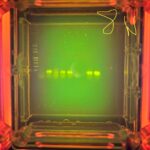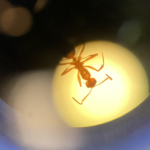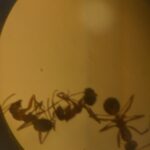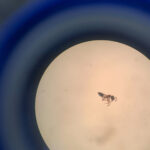Sample information |
|
| Picture |

|
|---|---|
| Location | |
| Collection date | 11/12/2024 |
| Captive / Cultivated? | Wild-caught |
| Group | Walton High School |
| Observations | Has a darkish brown/black exoskeleton with orange/red ends. Most body segments appear to contain two pairs of white colored legs. The two white antennae can be seen at the anterior end of the millipede with the mouth and mandible inferior to the antennae. |
| Putative identification | Arthropoda Diplopoda Polydesmida Euryuridae Euryurus Euryurus leachii |
Methods |
|
| Extraction kit | DNeasy (Qiagen) |
| DNA extraction location | Abdomen |
| Single or Duplex PCR | Single Reaction |
| Gel electrophoresis system | MiniPCR |
| Buffer | TBE |
| DNA stain | GelGreen |
| Gel images |

|
| Protocol notes | Lane 1 includes the DNA marker of double-stranded DNA fragment sizes 10k, 6k, 3k, 2k, 1k, 800, 600, 400, and 200 bp. The Gel shown is of the Wolbachia protocol, testing for the 16s rRNA gene only using specific primers. Lane 7 is of my leach’s train millipede arthropod sample, with the negative arthropod control in lane 9 and the negative DNA control in lane 10. The positive arthropod control and the positive DNA control were not run in the Wolbachia protocol gel due to errors during preparation. The Arthropod protocol gel is not shown due to unclear results. |
Results |
|
| Wolbachia presence | Unknown |
| Confidence level | Low |
| Explanation of confidence level | The Leach’s Train Millipede DNA sample that was tested for the Wolbachia 16s rRNA gene had no visible bands on the gel, which could indicate that this arthropod sample was negative for the Wolbachia 16s rRNA gene. However, the negative DNA control and negative arthropod control that were also run on the gel had visible bands when they shouldn’t, which could indicate errors in previous lab procedures. The millipede arthropod sample cannot be determined for sure to be negative for Wolbachia because the controls showed an unexpected result on the gel. Therefore, it cannot be confidently determined that this arthropod sample is negative for Wolbachia or was also prepared incorrectly which would result in no bands. |
| Wolbachia 16S sequence | |
| Arthropod COI sequence |
|
| Summary | |
 Formica Pallidefulva
Formica Pallidefulva Formica Pallidefulva
Formica Pallidefulva Ant
Ant Differential Grasshopper – Melanoplus differentialis
Differential Grasshopper – Melanoplus differentialis Pill Bug (Armadillidium vulgare) – Draft
Pill Bug (Armadillidium vulgare) – Draft